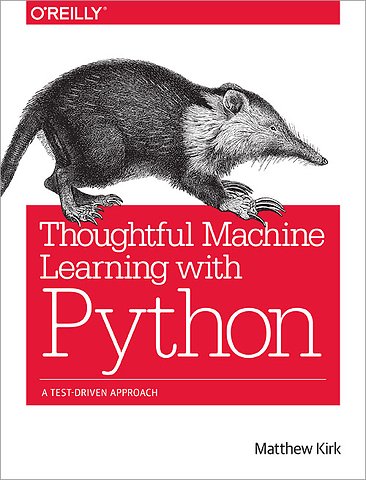


Matthew Kirk has always been “the math guy” to those that know him best. He started his career as a quantitative financial analyst with Parametric Portfolio.
Meer over Matthew KirkThoughtful Machine Learning with Python
A Test-Driven Approach
Paperback Engels 2017 1e druk 9781491924136Samenvatting
Gain the confidence you need to apply machine learning in your daily work. With this practical guide, author Matthew Kirk shows you how to integrate and test machine learning algorithms in your code, without the academic subtext.
Featuring graphs and highlighted code examples throughout, the book features tests with Python’s Numpy, Pandas, Scikit-Learn, and SciPy data science libraries. If you’re a software engineer or business analyst interested in data science, this book will help you:
- Reference real-world examples to test each algorithm through engaging, hands-on exercises
- Apply test-driven development (TDD) to write and run tests before you start coding
- Explore techniques for improving your machine-learning models with data extraction and feature development
- Watch out for the risks of machine learning, such as underfitting or overfitting data
- Work with K-Nearest Neighbors, neural networks, clustering, and other algorithms
Specificaties
Lezersrecensies
Inhoudsopgave
1. Probably Approximately Correct Software
-Writing Software Right
-Writing the Right Software
-The Plan for the Book
2. A Quick Introduction to Machine Learning
-What Is Machine Learning?
-Supervised Learning
-Unsupervised Learning
-Reinforcement Learning
-What Can Machine Learning Accomplish?
-Mathematical Notation Used Throughout the Book
-Conclusion
3. K-Nearest Neighbors
-How Do You Determine Whether You Want to Buy a House?
-How Valuable Is That House?
-Hedonic Regression
-What Is a Neighborhood?
-K-Nearest Neighbors
-Mr. K’s Nearest Neighborhood
-Distances
-Curse of Dimensionality
-How Do We Pick K?
-Valuing Houses in Seattle
-Conclusion
4. Naive Bayesian Classification
-Using Bayes’ Theorem to Find Fraudulent Orders
-Conditional Probabilities
-Probability Symbols
-Inverse Conditional Probability (aka Bayes’ Theorem)
-Naive Bayesian Classifier
-Naiveté in Bayesian Reasoning
-Pseudocount
-Spam Filter
-Conclusion
5. Decision Trees and Random Forests
-The Nuances of Mushrooms
-Classifying Mushrooms Using a Folk Theorem
-Finding an Optimal Switch Point
-Pruning Trees
-Conclusion
6. Hidden Markov Models
-Tracking User Behavior Using State Machines
-Emissions/Observations of Underlying States
-Simplification Through the Markov Assumption
-Hidden Markov Model
-Evaluation: Forward-Backward Algorithm
-The Decoding Problem Through the Viterbi Algorithm
-The Learning Problem
-Part-of-Speech Tagging with the Brown Corpus
-Conclusion
7. Support Vector Machines
-Customer Happiness as a Function of What They Say
-The Theory Behind SVMs
-Sentiment Analyzer
-Aggregating Sentiment
-Mapping Sentiment to Bottom Line
-Conclusion
8. Neural Networks
-What Is a Neural Network?
-History of Neural Nets
-Boolean Logic
-Perceptrons
-How to Construct Feed-Forward Neural Nets
-Building Neural Networks
-Using a Neural Network to Classify a Language
9. Clustering
-Studying Data Without Any Bias
-User Cohorts
-Testing Cluster Mappings
-K-Means Clustering
-EM Clustering
-The Impossibility Theorem
-Example: Categorizing Music
-Conclusion
10. Improving Models and Data Extraction
-Debate Club
-Picking Better Data
-Feature Transformation and Matrix Factorization
-Ensemble Learning
-Conclusion
11. Putting It Together: Conclusion
-Machine Learning Algorithms Revisited
-How to Use This Information to Solve Problems
-What’s Next for You?
Index
Anderen die dit boek kochten, kochten ook
Rubrieken
- advisering
- algemeen management
- coaching en trainen
- communicatie en media
- economie
- financieel management
- inkoop en logistiek
- internet en social media
- it-management / ict
- juridisch
- leiderschap
- marketing
- mens en maatschappij
- non-profit
- ondernemen
- organisatiekunde
- personal finance
- personeelsmanagement
- persoonlijke effectiviteit
- projectmanagement
- psychologie
- reclame en verkoop
- strategisch management
- verandermanagement
- werk en loopbaan





